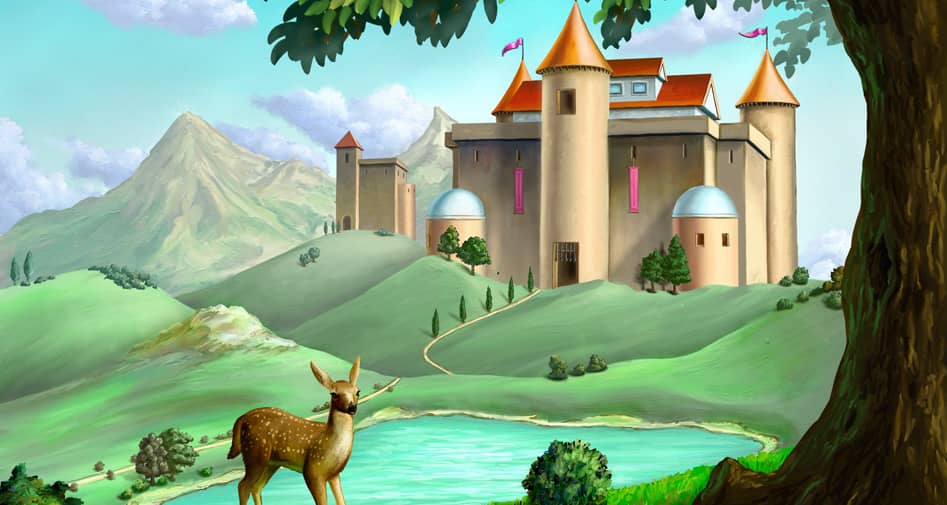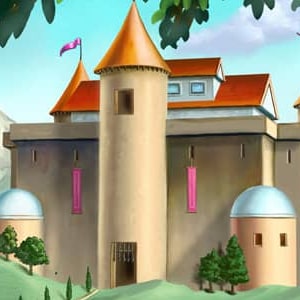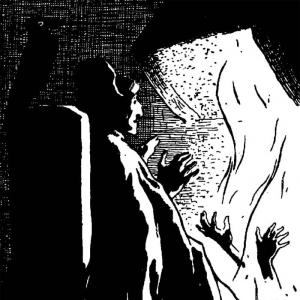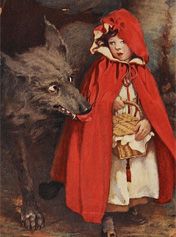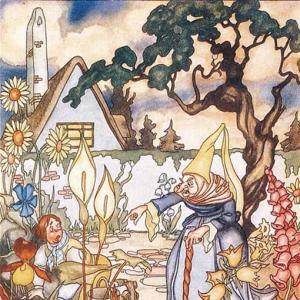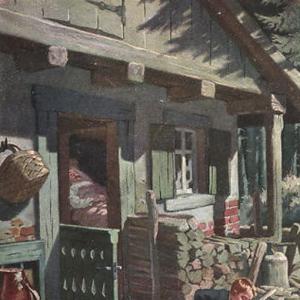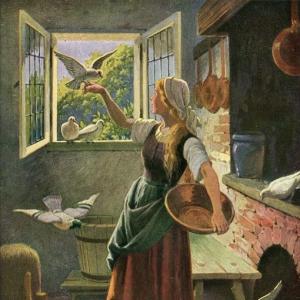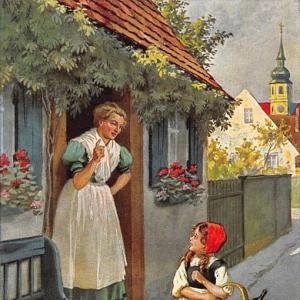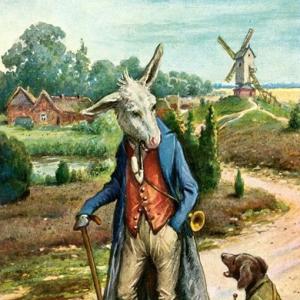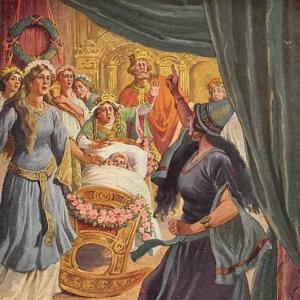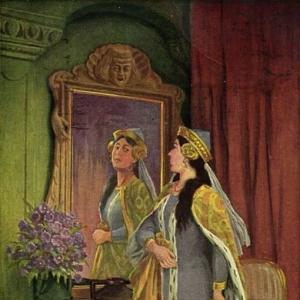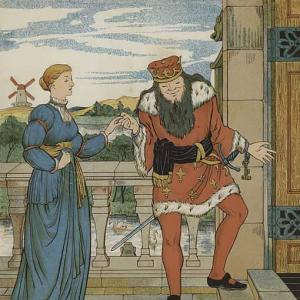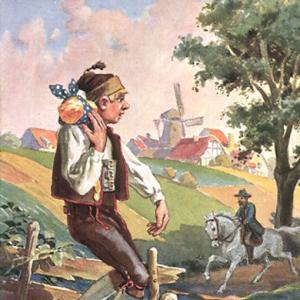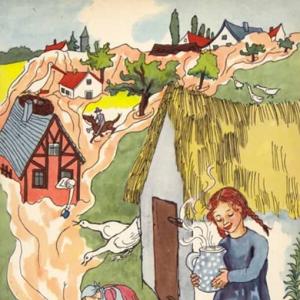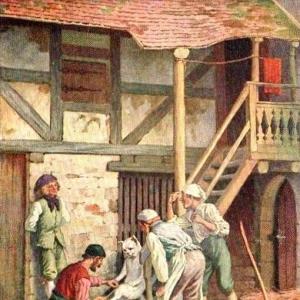Reading time for children: 7 min
Two or three hundred years ago, when people were far from being so crafty and cunning as they are now-a-day, an extraordinary event took place in a little town. By some mischance one of the great owls, called horned owls, had come from the neighboring woods into the barn of one of the townsfolk in the night-time, and when day broke did not dare to venture forth again from her retreat, for fear of the other birds, which raised a terrible outcry whenever she appeared. In the morning when the man-servant went into the barn to fetch some straw, he was so mightily alarmed at the sight of the owl sitting there in a corner, that he ran away and announced to his master that a monster, the like of which he had never set eyes on in his life, and which could devour a man without the slightest difficulty, was sitting in the barn, rolling its eyes about in its head. „I know you already,“ said the master, „you have courage enough to chase a blackbird about the fields, but when you see a dead hen lying, you have to get a stick before you go near it. I must go and see for myself what kind of a monster it is,“ added the master, and went quite boldly into the granary and looked round him. When, however, he saw the strange grim creature with his own eyes, he was no less terrified than the servant had been. With two bounds he sprang out, ran to his neighbours, and begged them imploringly to lend him assistance against an unknown and dangerous beast, or else the whole town might be in danger if it were to break loose out of the barn, where it was shut up. A great noise and clamour arose in all the streets, the townsmen came armed with spears, hay-forks, scythes, and axes, as if they were going out against an enemy; finally, the senators appeared with the burgomaster at their head. When they had drawn up in the market- place, they marched to the barn, and surrounded it on all sides. Thereupon one of the most courageous of them stepped forth and entered with his spear lowered, but came running out immediately afterwards with a shriek and as pale as death, and could not utter a single word. Yet two others ventured in, but they fared no better. At last one stepped forth; a great strong man who was famous for his warlike deeds, and said, „You will not drive away the monster by merely looking at him. We must be in earnest here, but I see that you have all tuned into women, and not one of you dares to encounter the animal.“ He ordered them to give him some armour, had a sword and spear brought, and armed himself. All praised his courage, though many feared for his life. The two barn-doors were opened, and they saw the owl, which in the meantime had perched herself on the middle of a great cross-beam. He had a ladder brought, and when he raised it, and made ready to climb up, they all cried out to him that he was to bear himself bravely, and commended him to St. George, who slew the dragon. When he had just got to the top, and the owl perceived that he had designs on her, and was also bewildered by the crowd and the shouting, and knew not how to escape, she rolled her eyes, ruffled her feathers, flapped her wings, snapped her beak, and cried, „Tuwhit, tuwhoo,“ in a harsh voice. „Strike home! strike home!“ screamed the crowd outside to the valiant hero. „Any one who was standing where I am standing,“ answered he, „would not cry, strike home!“ He certainly did plant his foot one rung higher on the ladder, but then he began to tremble, and half-fainting, went back again. And now there was no one left who dared to put himself in such danger. „The monster,“ said they, „has poisoned and mortally wounded the very strongest man among us, by snapping at him and just breathing on him! Are we, too, to risk our lives?“ They took counsel as to what they ought to do to prevent the whole town being destroyed. For a long time everything seemed to be of no use, but at length the burgomaster found an expedient. „My opinion,“ said he, „is that we ought, out of the common purse, to pay for this barn, and whatsoever corn, straw, or hay it contains, and thus indemnify the owner, and then burn down the whole building, and the terrible beast with it. Thus no one will have to endanger his life. This is no time for thinking of expense, and niggardliness would be ill applied.“ All agreed with him. So they set fire to the barn at all four corners, and with it the owl was miserably burnt. Let any one who will not believe it, go thither and inquire for himself.
 Learn languages. Double-tap on a word.Learn languages in context with Childstories.org and Deepl.com.
Learn languages. Double-tap on a word.Learn languages in context with Childstories.org and Deepl.com.Backgrounds
Interpretations
Adaptions
Summary
Linguistics
„The Owl“ is a lesser-known fairy tale collected by the Brothers Grimm, who were German academics, linguists, and cultural researchers named Jacob and Wilhelm Grimm. They are best known for their work in compiling, documenting, and popularizing traditional folktales from across Europe in the early 19th century.
The Brothers Grimm published their first collection of folktales, titled „Children’s and Household Tales“ (Kinder- und Hausmärchen), in 1812. The collection underwent several revisions and expansions over the years, with the seventh and final edition being published in 1857. The collection contains some of the most popular and enduring fairy tales, such as „Cinderella,“ „Snow White,“ „Rapunzel,“ „Hansel and Gretel,“ and „Little Red Riding Hood.“ However, it also includes lesser-known tales like „The Owl.“
The fairy tales collected by the Brothers Grimm often reflect the social, cultural, and historical context of the times in which they were recorded. These stories typically explore themes such as morality, human nature, and the power of storytelling, while also incorporating elements of fantasy, magic, and adventure. The Grimm brothers‘ work has had a significant impact on literature, folklore studies, and popular culture, with many of their stories being adapted into various forms of media, such as movies, television shows, and stage plays.
„The Owl“ by Brothers Grimm can be interpreted in several ways, exploring themes such as fear, ignorance, mob mentality, and the consequences of overreaction.
Fear of the unknown: The townspeople’s reaction to the owl demonstrates their fear of the unknown. They are unable to recognize the creature, and their imagination turns it into a dangerous monster. This theme suggests that fear can often stem from a lack of knowledge and understanding.
Ignorance: The story highlights the ignorance of the townspeople, who are unable to identify the owl as a harmless bird. Their inability to reason and seek information leads them to take drastic measures against a perceived threat. This theme reminds readers of the dangers of ignorance and the importance of education and awareness.
Mob mentality: The townspeople’s collective fear and panic lead to mob mentality, where individuals lose their ability to think rationally and act based on the influence of the group. The collective hysteria causes them to overreact and ultimately burn down the barn, illustrating the consequences of succumbing to mob mentality.
Overreaction and consequences: The story also focuses on the consequences of overreaction. The townspeople’s irrational fear leads them to destroy an entire barn and its contents to eliminate a perceived threat, ultimately causing unnecessary loss and harm. This theme serves as a cautionary tale, emphasizing the importance of rational thinking and measured responses to perceived dangers.
Satire and criticism of authority: The story can be seen as a satirical portrayal of the townspeople, including the burgomaster and the town’s leaders, who fail to recognize the owl for what it is. Their inability to make informed decisions and guide the town in a rational manner highlights the potential shortcomings of authority figures, encouraging readers to question and critically evaluate the decisions of those in power.
„The Owl“ is a lesser-known fairy tale from the Brothers Grimm collection, so there are not as many adaptations as some of their more popular stories. However, there have been a few adaptations over the years. Here are some examples.
„The Owl“ was adapted into a short film in 1988 called „Die Eule,“ directed by Teresa von Mende. The film stays faithful to the original story, with the owl helping the young man on his journey and then leaving him when he forgets about her.
The story has been adapted into a children’s book called „The Owl“ by Jackie Morris. The book uses Morris’s stunning illustrations to bring the story to life and make it more accessible to young readers.
In 2018, the story was adapted into a play called „The Owl and the Pussycat“ by Tim Supple and David Tushingham. The play updates the story and sets it in a modern-day city, with the owl and the young man navigating the urban landscape together.
The story has also been adapted into several retellings and reimaginings by various authors. For example, author Anne Rice wrote a novel called „The Master of Rampling Gate“ that incorporates elements of „The Owl“ into the story.
Overall, while „The Owl“ may not be as well-known as some other Brothers Grimm fairy tales, it has still inspired several adaptations and retellings over the years.
„The Owl“ is a fairy tale by Brothers Grimm, set in a small town a few centuries ago. One day, a horned owl accidentally found refuge in a barn, causing great panic among the townsfolk. The man-servant who discovered the owl was frightened by its appearance and described it as a dangerous monster. The barn owner, initially skeptical, also grew terrified upon seeing the owl and sought help from the neighbors.
The entire town gathered, armed with various weapons, and surrounded the barn. One by one, brave men ventured inside to confront the owl but emerged pale and speechless. Finally, a renowned strongman armed himself and climbed a ladder to reach the owl, who was perched on a cross-beam. As the crowd outside cheered him on, the owl ruffled its feathers, flapped its wings, and snapped its beak, causing the man to retreat in fear.
With no one else willing to confront the owl, the townspeople feared their town would be destroyed. The burgomaster proposed buying the barn and its contents from the owner, then burning the entire building to kill the owl. Everyone agreed, and the barn was set on fire, resulting in the owl’s unfortunate demise. The story concludes by challenging skeptics to verify the tale’s truth for themselves.
The Brothers Grimm’s fairy tale „The Owl“ presents a rich text for linguistic and stylistic analysis.
Narrative Style: The story is written in a third-person omniscient perspective, typical of fairy tales, which allows the narrator to provide insights into the thoughts and feelings of multiple characters. This perspective also enables the story to maintain a tone of objectivity and detachment, which enhances the comedic effect of the humans‘ irrational fear and overreaction to the owl.
Language and Diction: The language used is relatively formal and archaic, reflecting the setting of „two or three hundred years ago. “ Words like „mischance,“ „clamor,“ „burgomaster,“ and „niggardliness“ contribute to a historical and almost quaint tone. This choice of diction sets the stage for a traditional fairy tale, grounding the reader in a past when superstitions and exaggerated fears were more common.
Characterization and Dialogue: Characters are superficially sketched, with their actions and reactions portrayed humorously. The dialogue reflects exaggerated fear and bravado, such as the servant’s report of a „monster“ in the barn and the townspeople arming themselves as if for battle. The mix of direct and indirect dialogue exemplifies typical storytelling techniques found in folklore, where speech often serves to reveal character and advance the plot.
Themes and Symbolism: The owl symbolizes the unknown and the irrational fears associated with it. The townspeople’s response illustrates themes of ignorance, fear of the unfamiliar, and the tendency of human beings to react with hysteria to what they do not understand. The burning of the barn represents misguided attempts to control and eliminate fear by destroying the perceived threat rather than understanding it.
Humor and Satire: The tale is infused with humor and satirical elements. The hyperbolic reaction of the townspeople to an owl—a creature that is harmless but perceived as monstrous—serves to mock human nature’s propensity for panic and overreaction. The use of irony is evident when the bravest man fails to confront the owl, and the ultimate solution is to burn down the barn, sacrificing property due to irrational fear.
Moral or Lesson: Like many fairy tales, „The Owl“ carries a moral, though delivered subtly through satire. It suggests that acting from blind fear and ignorance leads to irrational and destructive actions. Instead of seeking understanding, the townspeople choose a costly and unnecessary course of action.
Overall, the linguistic features, narrative style, and thematic elements in „The Owl“ combine to create a tale that is both entertaining and didactic, encouraging readers to reflect on their own responses to what they do not understand.
Information for scientific analysis
Fairy tale statistics | Value |
|---|---|
| Number | KHM 174 |
| Aarne-Thompson-Uther-Index | ATU Typ 1281 |
| Translations | DE, EN, DA, ES, FR, PT, HU, IT, JA, NL, PL, RU, TR, VI, ZH |
| Readability Index by Björnsson | 39 |
| Flesch-Reading-Ease Index | 73.6 |
| Flesch–Kincaid Grade-Level | 9 |
| Gunning Fog Index | 11.6 |
| Coleman–Liau Index | 8.4 |
| SMOG Index | 9.4 |
| Automated Readability Index | 10.1 |
| Character Count | 4.492 |
| Letter Count | 3.491 |
| Sentence Count | 35 |
| Word Count | 849 |
| Average Words per Sentence | 24,26 |
| Words with more than 6 letters | 125 |
| Percentage of long words | 14.7% |
| Number of Syllables | 1.090 |
| Average Syllables per Word | 1,28 |
| Words with three Syllables | 41 |
| Percentage Words with three Syllables | 4.8% |
